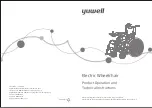
Fitting and using the combined webbing tie-down & 3 point double inertia
Fit and use
3 point double inertia seatbelt
•
Unwin recommends the use of a 3 point occupant restraint system to provide greater protection in case of an impact. However
we also recognise that some vehicle layout/designs or specific postural or medical conditions do not allow that style of seatbelts
to be used easily.
•
This system is not ISO 10542 compliant if used in 2 point configuration.
•
Before fitting the occupant restraint, ensure that the reversible or fixed stalk button is facing outside in relation to the wheelchair.
With the reversible stalk, if orange button faces inside, turn the stalk 180º to sit in the right position.
•
In accordance with International regulations, standard Unwin occupant restraints are designed to be used for passengers weighing
22kg or above. If the passenger weighs less than 22kg, Unwin recommend that a suitable, and appropriately tested child restraint
seat is used. This may involve a secondary seat belt restraint as recommended by the original seat manufacturer.
1. Position the third point fixing into the cant rail, (Fig 8), so that it is vertically above the inertia reel
casing fixed onto the floor fixing. Unfasten the tongue and buckle.
2. Pull the black webbing upwards and unfasten the tongue from the grey webbing buckle.
3. Position the black webbing to form the lap belt and insert the tongue into the buckle stalk, (Fig 9).
4. Ensure that the lap belt lays low on the pelvis of the occupant, running as close as possible over
the hips on both sides.
5. Remove the black plastic cover on the grey shoulder belt tongue and fit into the third point fixing.
6. Position the grey webbing to form the shoulder belt and insert the buckle into the tongue.
7. Adjust the height of the shoulder belt to clear the occupant’s shoulder by approximately 25mm -
1 inch, (Fig 10).
8. The lap belt anchor points should be positioned to achieve belt angles of 30° or more to the
horizontal and preferably between 45° and 75° in order to fit low across the pelvis reducing the
possibility of the belt loading the abdomen, (Fig 7). The pelvic restraint is designed to bear upon
the bony structure of the body and should be worn low across the front of the pelvis with any
junctions between the pelvic and shoulder restraints located near the wearers hips.
Removing occupant restraint
1. Release the grey shoulder belt from
the lap belt section, then from the
third point fixing and carefully allow
the shoulder belt to return to the
retractor.
2. Disconnect the black lap belt from
the buckle stalk on the aisle side and
carefully allow the lap belt webbing
to return onto it’s retractor.
3. Connect the shoulder belt buckle
to the lap belt tongue above the
opening of the retractor box.
4. The wheelchair tie-down should
now be removed.
12
Combined webbing tie-downs with 2 & 3 point occupant restraints
Wheelchair & occupant restraint










































